 |
 |
 | |
| |||

Ratshilumela Samson Mudzunga emerges from one of his drums.
|
Ratshilumela Samson Mudzunga plans two groundbreaking performances in the Northern Province
Any press release entitled 'There Are No Zombies Zwidudwane at Lake Fundudzi!' has got my attention immediately. Although I'm familiar with Northern Province artist Samson Mudzunga's embellished iron wood drums, the complexity of the relationship between this production, his performative work and his cultural context look to be brought into sharp focus with a planned 'mazhakandila' (celebration) on Dopeni Shanzha Village on July 29. Mudzunga is one of those rare beings whose rich artistic practice melds inextricably with his life in rural Venda, so much so that despite being relatively unaware of contemporary visual arts practices, his work reads as close in intention to artists working out of urban centers. As such, increasing attention is being paid to Mudzunga, who is one of the artists selected for a monograph in the IFAS/Pro Helvetia/MTN sponsored series. Along with Jo Ractliffe and Jeremy Wafer, the three are next in line for publication, and Mudzunga is also the focus of a seeing ourselves documentary, a series of short films on South African artists. His book will be co-authored by Kathy Coates and Stephen Hobbs and edited by Brenda Atkinson. The first planned event is designed to mark the beginning of the end of a jealous rivalry between Mudzunga and local headsman Samuel Netshiava that has lasted a few years already. When Mudzunga was denied access by Netshiava to the hallowed and mythical Lake Fundudzi for a performance in 1997 and subsequently, Netshiava's kraal burnt down, Mudzunga was arrested on charges of arson, apparently committed in retaliation. The lake enjoys sacred status in the Tshivhasa community to which Mudzunga belongs, but although he respects this tradition, he is somewhat skeptical of the superstitions that surround this place. As such, it appears that his success and position in the community were perceived as a threat to Netshiava, and it is Mudzunga's belief that the simplest way to humiliate and get rid of him was to have him arrested and jailed. Bail was set at an astonishing R30 000 and without the means to secure this kind of money, he spent eight months as an awaiting-trial prisoner before bail was reduced to R5 000 and he could pay his way out. While imprisoned, he was not informed of the death and burial of his 110-year old mother, a woman purported to have remarkable healing powers and to whom Mudzunga was very close. Finding an enormous tree which he received permission to cut down, Muzdunga fashioned a unqiue coffin-drum, large enough for eight people to play from the inside. This drum is to form the central motif for this performance which will culminate in a burial-and-resurrection performance planned for October, but for which Mudzunga is still seeking funding. The latter performance was planned for Johannesburg in October last year, but six weeks before it was scheduled to take place, he was arrested again, this time accused of plotting to kill his half-brother by using the escape tunnel of his planned 'grave' (that would be used by Mudzunga to 'resurrect' himself) to commit murder with a perfect alibi of being 'buried'. Jailed for a further ten months, this performance scheduled for July 29 is an act of reconciliation and catharsis, intended to smooth over events fuelled by jealously which have gone beyond the immediate protagonists to affect the community at large. Now while this is a fantastic and tragic story, it also contains a whiff of hype. While Mudzunga deeply challenges the cultural intersection between 'traditional' and 'contemporary' practices, he is not unaware of the processes of self-promotion - the 'burial' performance was satirical in design, drawing attention to his perceived position as an artist-visionary-pariah in an apparently hostile community. But having said this, Mudzunga is also driven by ritual and personal compulsions - the 'grave site' was to house his mother's memory through her personal belongings and healer's accoutrements. He has now received the blessing of Chief Kennedy Tshivasa to carry out his vision. The public is invited to attend the celebrations in Venda this weekend. A list of contacts is provided below for directions and accommodation arrangements. A fee of R15 per person is payable by people attending to cover the costs of some 50 dancers who will participate in the event, which includes Mudzunga's baptism by the Archbishop of Germany.
Samson Mudzunga 082 752 8263
| ||
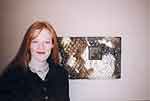
Fiona Couldridge
|
Two South Africans win ROSL Arts Travel Scholarships
Congratulations to young Johannesburg artist Fiona Couldridge and Mzukisi Dyaloyi of Grahamstown for each winning one of five prestigious Royal Over-seas League travel scholarships. Artists under the age of 35 from Australia, Bangladesh, Jamaica, South Africa and the UK were invited to submit slides of recent work to ROSL Arts. Other artists selected were Matthew Burroughs (UK), Sarkar Nahid Niaza (Bangladesh) and Savandhary Vongpoothorn (Australia). They receive an all-expenses paid trip to the UK, spending one month in residence at the Patrick Allan Fraser Foundation at Hospitalfield in Arbroath. From there, they can choose between seven more days in either London or Edinburgh and receive a cash award of �500. In 2001, a group exhibition will be held at Over-seas House in London and ROSL Arts will bear all costs of return trips to the UK, freighting of work, accommodation and hospitality. Couldridge, a lecturer at the Johannesburg Art Foundation and curator of the Foundation's Bill Ainslie Gallery will take up her residency in mid-August and has opted for Edinburgh over London. Her unique style of combining relief sculpture with painting to create evocations of the insects, reptiles and crustaceans we love to hate is sure to demand attention.
| ||

Winner Terry Kurgan at the Vita Awards ceremony
|
Terry Kurgan is this year's Vita star by Kathryn Smith Johannesburg's sub-zero weather did not appear to affect crowd turnout at this year's FNB Vita Art Prize announcement. Terry Kurgan scooped the R30 000 prize, and deservedly so. This year's show is contained, accomplished and dare I say, even elegant. The pared-down quality that has resulted from only four commissioned nominees instead of the maximum six has allowed each of the artists to really 'own' their spaces without any one artist dominating the gallery space. Kurgan's diaphanous grand-scale digital prints on silk organza are truly spectacular and after a quick crowd-survey, it appeared that she had a unanimous vote from those present.
| ||
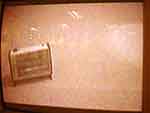
Brad Hammond
Colbert Mashile
|
Brad Hammond wins Absa Atelier Award 2000 by Kathryn Smith With local celebrity Nataniel and media figure Tim Modise co-hosting, pomp and glitz was to the fore at the15th Absa Atelier Awards 2000 held at the super-flash Absa corporate headquarters in downtown Johannesburg last week. The quietly brilliant Brad Hammond, self-effacing as ever, was awarded the coveted prize of a studio residency in Paris for his introspective and lyrical video piece entitled Inner City. In three separate films, Hammond finds the meditational and spiritual in relatively mundane images. A rippling body of water in increasingly distant focus becomes a metaphor for video-noise, the grey specks that carry latent information, if only we had the ability to decode it. The regular pulse and flash of the now- replaced Coke sign atop Ponte City is an urban mantra, rhythmic and soothing, intercut with words tracking the movements of the flashing lights. And a domestic heater gets red hot and cools down with the ambient noises of suburban life in the distance. Nigel Mullins, Natasha Christopher, Joni Brenner and Colbert Mashile each received merit awards worth R10 000 each, given for individual works. My own feeling was that in several cases, other works by the merit award-winning artists were often stronger than those selected. The nature of the ABSA selection process is to choose individual works at regional level, which means that several entries from one artist may end up on the exhibition, giving a more coherent idea of an otherwise decontextualised practice. It was good to see that this was the case not only for the winners but the other artists on the exhibition. Generally speaking, the quality of work on exhibition is uneven, as is always the case with competitions, but having said the obvious, there are some unrecognized gems amongst some very mediocre stuff. Back to the merit winners. Brenner's entry, Recollect: Reconnect is a sophisticated and mature exploration of surface, interpretation and form. Two postcard reproductions of Rodin's La Pensee are juxtaposed with two small but heavily-worked and paint-laden, viscous canvases. The effect of the paintings is that of a microscopic gaze at the actual surface of the original sculpture. Painting and sculpture as orthodox disciplines collapse in on themselves and the pristine presentation in a perspex 'museum' case compounds an already complex but beautifully subtle work that may suffer from a little too much theorising for the untrained viewer. Christopher's Making Sense of Things explores memories and moments either missed or fleetingly present. By isolating a single image from a video that recorded a spiritually and emotionally-loaded family event, her desire to position herself now in relation to that which has passed results in an ambiguous but strangely familiar image that bespeaks psychological space rather than a specific location. Colbert Mashile's Koma II was a firm favourite for many viewers even from the regional round of the show. Exploring a hitherto unspoken terrain of masculinity and ritual circumcision, the depth of intensity and sensitivity in Mashile's work is remarkable. Nigel Mullins presents a multi-unit painting called An Aesthetic for Cruelty and Violence which references both historical and contemporary images of martyrdom and torture. Attempting to locate and consolidate a general state of human violence and cruelty over time is a project that would appear stillborn, if not simply obvious. And the painting style, although not entirely inappropriately, references our own Robert Hodgins and his British contemporary, Francis Bacon. But while the final effect may please, it feels a bit Brit-poppy - surface and gloss with only a tenuous hold on the potential of the subject matter. The exhibition is on view at the Absa Gallery and ends on August 14.
| ||
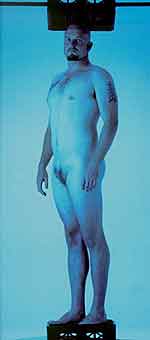
Peet Pienaar
Thembinkosi Goniwe
|
Cultural apartheid? Circumcision proposal provokes questions. by Sue Williamson Questions of artistic freedom, cultural traditions, sterile conditions, and the problems of sponsorship have arisen from a proposal by performance artist Peet Pienaar to publicly undergo circumcision in a cubicle in an art gallery as his piece for an eight-man show entitled 'Men and Masculinity' planned for October. The gallery is the AVA in Cape Town, and Pienaar has proposed that a black medical doctor carry out the delicate operation. The British curator is Jeremy Mulvey, who has previously organised shows on the same theme in London and Barcelona, and has invited four British artists and four South African to take part. Under the headline 'Artist cut up over gallery's refusal to host circumcision', the Sunday Times on July 9 suggested that Pienaar, a 'white Afrikaans artist' was embroiled in a row with two of his fellow artists on the show, Thembinkosi Goniwe and Zwelethu Mthethwa, saying that the two believed Pienaar's 'work' was disrespectful towards black culture. The story inferred that the black artists were censoring the proposal. Responding to the story in the Times, Goniwe denied that he had 'objected' to Pienaar's proposal. 'When I read the proposal, it was very interesting to me since my own work for the show deals with male circumcision', said Goniwe today. 'I never wanted Peet out of the show. I never said that Peet couldn't do this, it's just I had some questions or rather concerns about Peet's idea. This is what I said to the news reporter Bonny Schoonakker. I told him I would have to meet with Peet first to discuss these concerns before responding. Instead, abusing his journalist position because of 'this good story' as he said to me, Schoonakker reduced the issue to 'racial censorship' in his article.' Pienaar's original proposal read in part: 'My idea for the exhibition is to get a medical doctor to circumcise me live in the gallery. The whole event would be broadcast live on the Internet , members of the public would be charged to access the site. After the performance, my foreskin would be auctioned live via the Website. For the remainder of the show I would like to show daily pictures documenting the healing of the penis which would also be displayed. 'Concept: In African tradition you are not a man unless you are circumcised, it is also a token of initiation as a man into society. The tradition is highlighted in the Xhosa culture where "manhood" or "initiation" rituals include circumcision, a practise which has become increasingly controversial in South African society, due to the deaths and infections which often accompany the ritual. While, in traditional culture, circumcision would be performed in a group ritual for young adults, in white culture it is an embarrassing thing to get circumcised when you are an adult and it is an operation that would normally be private and confidential. Thus, by showing the performance live on the Net, in front of an audience, I am highlighting the strange tension that exists in this country between tradition (traditional concepts of masculinity) and technology (new concepts of masculinity). By auctioning the foreskin I am exploring how new concepts of masculinity are built around money and capital worth as opposed to the tradition and physical.' Goniwe said today, 'I would never censor an artist from doing what s/he wants to do. But having said that, an artist must take responsibility for his/her work, thus I will question the artist's work/idea if necessity invites me to do so. Pienaar says, 'In African tradition you are not a man unless you are circumcised,' but which African tradition is he talking about? The west Africa, east Africa, southern Africa? It's not true for every part of the continent. This in part illustrates the danger of being less informed, and yet buying into the established danger of colonial left-overs. Thus I am inclined to ask when is the re-colonising and the reframing of 'the other', as well as the exploitation of 'the other's culture' going to come to an end?' 'I should also ask, if one is practising circumcision as part of the Xhosa ritual, and in the name of "art" reduces the ritual to a commodity by offering the foreskin for sale on the net, what does this say to those the ritual originate and who sensitively hold dear and are emotional about the ritual? Isn't this going to be offensive to some extent, inviting questions abuse, violation, and forth? These were the kind of concerns I was interested to raise with Pienaar.' The AVA Gallery had its own anxieties about the piece - performing an operation such as a circumcision in the non-sterile and very public gallery could well be not only a health risk but be frowned upon by Metropolitan Life, sponsors of the space. From London, curator Jeremy Mulvey commented, 'a strength of the piece for us seems to be offered as a charged and confrontational metaphor for the continued tensions between black and white culture, particularly amongst men, beyond apartheid.' At the same time, Mulvey raises questions about possible readings of the piece, and feels it imperative that the South African co-ordinator, Jill Trappler and Gallery director Estelle Jacobs are involved in a decision about the final form of the piece. A compromise is in the air. Zwelethu Mthethwa is out of town, but Pienaar and Goniwe met on Friday with the fourth artist involved, Andrew Porter, and it now seems likely that Pienaar will have the circumcision performed elsewhere, possibly a week before the show, and his actual piece on the show will be a video presentation, a computer with an internet link, and maybe, Orlan-style, some work which might include, as Mulvey puts it 'a suitably contained foreskin'. - ArtThrob has invited Thembinkosi Goniwe to write an article for next week's issue on the subject of the current politics of representation in South Africa, addressing this and other questions.
| ||
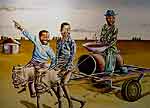
Zondi Skosana
Abrie Fourie
|
Kempton Park Tembisa Fine Art Award Winners This year's Kempton Park Tembisa Fine Art Award received over 300 submissions, out of which 103 were selected for exhibition. A lack of any kind of curatorial impetus in terms of how the show was hung, as well as a really confusing Top 14 selection, makes a review rather impossible. Despite these things, the Kempton Park Tembisa Metropolitan Council deserves praise for its tireless efforts in hosting this show each year. There's something to said for a small council which manages to raise more money than a major corporate sponsor like Sasol (New Signatures). However, if the Council want this award to be taken seriously as an event on the contemporary fine arts calendar, they need to find a new venue, pronto. Brown brick walls and violent turquoise postmodern-esque architectural features do nothing for the works on display, other than making them look like square pegs shoved into round holes. Zondi Skosana from KwaNdebele received first prize (R12 000) for his lyrical but disquieting paintings entitled B(l)ack by popular demand and Bazolenda (falling), with Jan van der Merwe of Pretoria scoring second place (R 7 000) for a poetic sculptural installation entitled Wag-Waiting. Third prize (R 5 000) went to fellow Pretorian Abrie Fourie for a seductive lightbox floor installation of images of discarded chairs called Pleasure and Luxury. Ends July 19.
Coen Scholtz Recreation Centre Hours: 10.00 a.m. - 5.00 p.m.
| ||
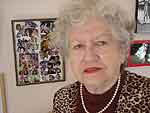
Gregg Smith
Gregg Smith
|
Art tabloid hits streets A new tabloid newspaper that looks at South African cities from the viewpoint of art and culture hits the streets on Saturday morning, July 1 in a choreographed production around major Johannesburg shopping centres. In Cape Town, Public Eye will be dropping off copies at selected outlets like trendy bars and galleries. To be given out free of charge, the pilot edition of RETREKS: UNTITLED BLURB, reveals cities as interesting cultural phenomena, and has been endorsed by the Department of Arts, Culture, Science and Technology. Johannesburg, Cape Town and Durban are explored in this first edition, and later issues will focus on other South African cities. "The aim of this newspaper is not only to document the density of art and cultural activity, but also to employ art - in its broadest sense - as a means of publicly visualising the experience of our cities," says the newspaper's overall editor, visual artist Rodney Place. "Cities, like literacy, education and the means of production, are fundamental to the development of the public integration we call modern democracy and should surely warrant a focusing device. "It is the aim of RETREKS: UNTITLED BLURB to let each city both speak and visualise for itself and to use the publication to begin the process of revealing - warts and all - the nature of each city's cultural density and future, and to do this through the imaginative techniques of art." Visual artists have been involved in putting the 16-page tabloid newspaper together. The section on Johannesburg was edited by artist Steven Hobbs, gallery director of the Market Theatre Galleries and written by freelance journalist Boetie Tsepho Damane. Durban was explored by Carol Brown, director of the Durban Art Gallery, and Cape Town is seen through a double page spread on an exhibition entitled 'Lovephones', produced by artist and photographer Gregg Smith, under the auspices of RETREKS Cape Town editor Robert Weinek for Public Eye - an arts organisation concerned with public art issues. For further information, please contact the producers of RETREKS, ZAR Works, (011) 614-6841 fax (011) 614-0916 or email: zarworks@iafrica.com
| ||
 
|
listings |
reviews |
news |
exchange |
feedback |
websites |
archive |
artbio |
project |
search |
home
|